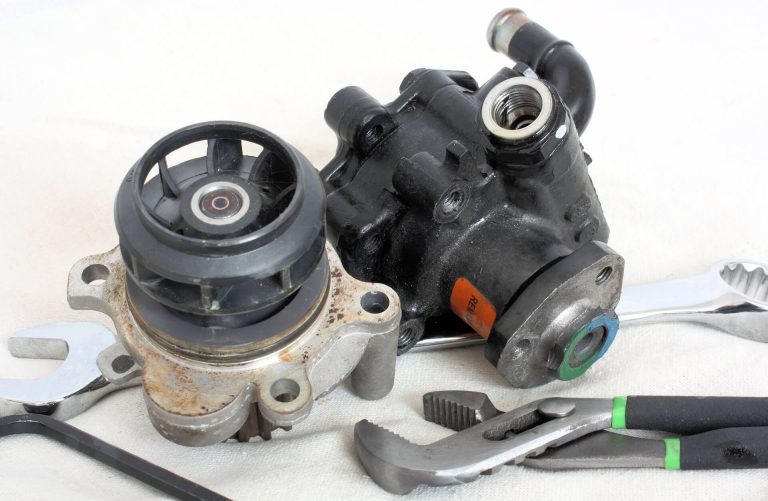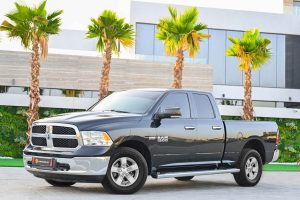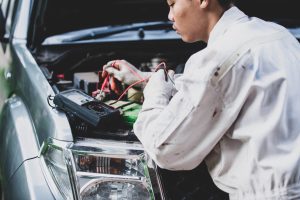A temporary fuel pump fix is a great way to get your car running again without replacing the existing fuel pump. Temporary fuel pumps are typically temporary solutions that help restore your vehicle’s basic functionality until you can get it serviced or replaced with a new unit.
While temporary fuel pump fix is not meant as a permanent solution, they can provide temporary relief while you determine the cause of your vehicle’s fuel pump failure. In some cases, temporary fixes may save you money until you can afford to replace the part.
Temporary fuel pump fix is often employed in situations where time and resources are limited, such as when a car is stranded due to mechanical failure in an unfamiliar area. It is crucial to consider temporary fuel pump fixes before making a decision, as they have advantages and disadvantages.
Table of Contents
ToggleWhat Is a Fuel Pump?
Unleashing your vehicle’s potential starts with the fuel pump – a device that transfers gas from the tank to your engine. Activated when you turn on your car’s ignition, it works by transferring liquid or gas through electricity. While most cars have one fuel pump, some larger vehicles may require two or more for optimal performance and efficiency.
Weak Fuel Pump Symptoms – What to Look Out For
If your fuel pump is not working, you will notice some signs. These warning signs will alert you to a malfunctioning fuel pump. Identifying weak fuel pump symptoms can help you take action before more severe damage occurs. Let’s take a look at some of the most common weak fuel pump symptoms.
Engine Performance Issues
One of the first warning signs of a weak fuel pump is an overall decrease in engine performance. If your car seems to have difficulty going faster or staying with other vehicles, this could mean the fuel pump is not working correctly. The lack of pressure caused by a weak pump will affect how much gas is being sent through the lines and eventually into the engine. This decrease in gas flow will cause your car’s performance to suffer significantly.
Noisy Engine Sounds
Another symptom that may indicate a potentially defective or weak fuel pump is noisy engine sounds coming from under the hood. If you hear unusual whining or humming noises when starting up your vehicle, then it’s time to take a trip to the mechanic. Don’t delay; get an appointment with a certified expert right away! They will be able to diagnose if this is due to any problems in your car’s fuel system and come up with the best solution for keeping you on the road.
Fluctuating RPMs
If your vehicle’s RPMs are wildly fluctuating while idling, notably if they’re dropping far lower than the usual rate, this might mean that your fuel pump is experiencing difficulties. A weak or damaged fuel pump will not provide adequate pressure and thus cannot maintain consistent RPMs while idling. This can also be accompanied by other issues like stalling and sputtering when starting up or accelerating quickly.
Noises From The Fuel Tank
One of the most common symptoms of a weak or failing fuel pump is strange noises coming from the fuel tank. Pay attention if you hear any whistling or humming noises when starting your vehicle, as this could indicate something wrong with the fuel pump. It also may be a sign of problems in the fuel filter or injectors and should not go unchecked – make sure to get it checked out right away!
Difficulty Starting Your Vehicle
Another symptom of a weak fuel pump is difficulty starting your vehicle. When you turn the key, your car should start right away. If it takes longer than usual or won’t start, there might be a problem with the fuel system. This could mean that the fuel pump is weak. Pay attention if you notice any changes in how easily and quickly your car starts after turning the key in the ignition.
Safety Considerations for Temporary Fuel Pump Fix
Dealing with car repairs can be challenging, and the fuel pump is one of the most complex components to address. Before you attempt a temporary fuel pump fix for your vehicle, many safety considerations should not be overlooked. Let’s dive deeper into these important safety measures!
Check the Gasoline Tank Level
Before working on the fuel pump, ensure the gas tank is not full. If it is, empty it first. When servicing the fuel system and dealing with combustible gases and vapors, ensure that no heat sources or sparks are present – otherwise, an explosion could occur. This means all cigarette lighters and other devices generating heat should be switched off immediately.
Wear Appropriate Clothing and Safety Gear
In order to ensure your safety when performing any kind of automotive maintenance or repair, it is essential to have a suitable outfit and protective equipment. Ensuring you wear thick rubber gloves and safety eyeglasses will help keep hazardous chemicals from coming into contact with your skin in case anything spills over.
Furthermore, long pants and a long-sleeved shirt are highly recommended when working around tight spaces with moving machinery parts such as belts and pulleys—providing an extra layer of safety.
Also, make sure that your clothing fits appropriately because loose clothing can easily get caught in machinery or spark an ignition source if it brushes against something hot, like an exhaust pipe or motorized parts like a fan belt.
Know Your Limits
If you are uncertain about how to perform a specific task related to your fuel pump repair job, know your limits and ask someone who knows what they are doing for help. Never attempt a task beyond your skill level, as this could result in significant damage being done to your vehicle or even injury due to improper use of tools or incorrect techniques used when handling hazardous materials such as gasoline or battery acid. It’s better to seek help than risk hurting yourself or others due to inexperience with automotive repairs.
How to Fix a Fuel Pump Without Replacing it ( Temporary Fuel Pump Fix )
A fuel pump is the heart of your car’s fuel delivery system. When it stops working, you can be in for a long and expensive repair job. But you don’t necessarily have to replace it right away. With some preventive maintenance and a few simple steps, you can know how to fix a fuel pump without replacing it. Here’s how.
Check Your Fuel Pump Relay
The first thing you should do is check your fuel pump relay. This is an important part of your vehicle’s electrical system that helps regulate the flow of electricity to the fuel pump. If the relay has gone bad, it could be preventing power from reaching the fuel pump and causing it to fail. To test whether this is the case, locate the relay in your car and use an ohmmeter or multimeter to measure its resistance level. If there is no or very low resistance, then this could indicate a faulty relay that needs to be replaced before attempting any other repairs on your fuel pump.
Clean Your Fuel Filter
If the relay seems fine, then you should move on to checking your fuel filter, as this may also be contributing to your fuel pump’s failure. If the filter is clogged with dirt or debris, it won’t allow enough gasoline through and could cause your engine to run poorly or not at all due to a lack of proper lubrication or combustion power. To clean out your filter, use carb cleaner and let it sit for a few minutes before rinsing it off with warm water and drying thoroughly with compressed air if available. Once cleaned, re-install it onto your car and see if that fixes the problem with your engine running smoothly again.
Check Your Fuel Line Connections
If both of these checks come up negative, then check all the connections in the intake manifold and hoses connecting to the engine block. These connections might have become loose because of driving over bumps or rough roads.
Tighten any loose connections using pliers or wrenches until they are snug but not overly tight so as not to damage them further than they already may have been damaged due to age or wear-and-tear over time from regular use and driving conditions experienced by most cars on today’s roads!
Use Starting Fluid
If your vehicle has low fuel pressure, it’s not getting enough fuel from the tank to start up properly. To temporarily resolve this issue, you can use starting fluid instead of gasoline as a fuel source for your engine until it starts up. Once you start the engine, let it run for five minutes to completely burn off the starting fluid from inside its combustion chamber. Otherwise, excessive fuel in its cylinders due to residual starting fluid may cause irreparable damage. Make sure to take your car in for servicing ASAP so that a faulty fuel pump can be addressed before any further harm is done.
Also Read: Temporary Fix for Stuck Brake Caliper
Tricks to Make your Fuel Pump Work
The temporary fixes may buy you some extra time, but if you want your fuel pump to last longer without repairs, there are several tricks and tips you can use. Here are a few of the best:
Use Fuel with High Quality
Low-grade gasoline is known to contain more impurities than high-quality fuel, which can have a negative effect on your fuel pump. To ensure it runs smoothly, opt for fuel from reputable stations with good ratings.
Top Off the Tank
If possible, try to keep the fuel tank as full as you can. This will help reduce the amount of strain put on the fuel pump and prevent it from getting overworked.
Regular Maintenance
Making sure your vehicle is always in good condition and all mechanical parts are correctly working will help reduce the risks of fuel pump deterioration. Sticking to a consistent maintenance plan should extend the life of your fuel pump significantly.
Stay Alert
Pay attention to any signs that may indicate there’s something wrong with your fuel pump, like changes in engine sound or performance. If you suspect an issue, don’t ignore it and take immediate action to get the problem solved.
By following these tips and temporary fixes, you can keep your vehicle running until you’re able to address the root cause. Doing this will reduce the cost of repair and hopefully prevent any long-term damage to your fuel pump.
Also Read: Best Ultrasonic Carburetor Cleaner
Frequently Asked Questions
How to Start a Car With a Bad Fuel Pump?
Starting a car with a bad fuel pump can be frustrating, but it is possible to start the engine without replacing the fuel pump. The first step is to check your battery connections, as a weak connection can make it difficult for the fuel system to activate. Next, try priming the fuel system by pouring a little gasoline into the carburetor. If you don’t have access to gasoline, using starting fluid can also get your engine started. Lastly, make sure that not too much oil has collected in the spark plugs or cylinders and creates combustion problems. Follow these steps for How to Start a Car With a Bad Fuel Pump, and you’ll be able to get your car running again!
What could be the cause of the fuel pump works but car wont start?
If your fuel pump works but car wont start, there are several other potential causes that could be at play. First, although the fuel pump may be running, it may not be pumping enough fuel to maintain ignition. A clogged fuel filter can also prevent the vehicle from starting and should be checked if this is suspected. Additionally, a faulty spark plug or distributor cap can prevent the car from starting, so be sure to inspect these components as well. Finally, it could be an issue with the battery or starter, in which case you’ll need to take it to a mechanic for further inspection and repairs.
How to prevent fuel pump failure?
The best way to prevent fuel pump failure is by taking good care of your engine. This means following a regular maintenance schedule with consistent oil changes and tune-ups and replacing any worn-out parts as soon as they start to show signs of damage.
Additionally, use high-quality gasoline and keep the fuel tank full whenever possible. Finally, it’s essential to pay attention to any variations in engine performance or noises that could suggest a fuel pump issue. By adhering to these steps, you can drastically decrease the risk of a failed fuel pump and save money on costly repairs down the road.
Will bad fuel pump cause check engine light?
Yes, a bad fuel pump can cause the check engine light to come on. In many cases, this is due to insufficient fuel pressure that can’t meet the needs of the engine. Additionally, a faulty fuel pump can also lead to spark plug misfires and other ignition problems that will turn on the check engine light as well. It’s essential to diagnose and fix the underlying issue as soon as possible, or else the problem can get worse over time.
Where is a fuel pump located?
The fuel pump is usually located in the fuel tank of the car and requires a unique extraction tool to access. Alternatively, it can sometimes be found under the hood, near or attached to the engine block. Though this may differ depending on the vehicle, it’s wise to refer to your owner’s manual for precise guidance when locating your fuel pump.
Final Words
A temporary fuel pump fix can be a great way to keep your car running until you’re able to get the root cause fixed. Nonetheless, it’s essential to bear in mind that short-term remedies must only be utilized in urgent circumstances. All long-term issues should still be addressed immediately. If you’re uncertain of exactly how and where to begin, your most reliable option is always taking your car to a professional technician for an evaluation. Taking care of your fuel pump and performing regular maintenance checks can go a long way in preventing potential problems down the road.







